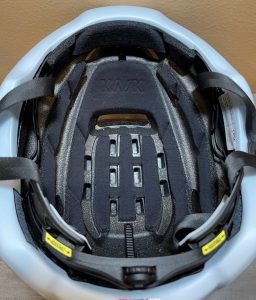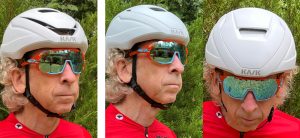KASK WASABI – JACK OF ALL RIDES?

My interest in the Kask Wasabi helmet started as a curiosity. In addition to the unusual decision to name a cycling product after a spicy sushi condiment, the helmet had attributes that just didn’t seem to go together.
It has a built-in, sliding panel to cover or uncover the helmet’s vents but is not promoted as Kask’s most aero or ventilated helmet. The foam pads that cushion your head are layered with Merino wool which signals warmth to me but the helmet is intended for use on hot days as well as cool ones. And its vent pattern, round shape, and matt finish give it, to put it kindly, a different look than most road helmets I’ve seen.
It isn’t lighter than other helmets even in Kask’s line and doesn’t come in eye-catching color choices or combinations. No added safety features like a crash notification sensor or light mounts exist.
But it sells for a discounted price of US$175/£109/€160 price.
So, what’s the Kask Wasabi raison d’etre?
Basically, Kask wants to give you the convenience of using one helmet for all riding conditions. Hot or cold temps, dry or wet skies, road or gravel surfaces, fast or slow rides, and the ability to adjust to those changing conditions without getting off your bike by merely opening or closing the vent cover with one hand.
Conditions like:
- Rolling out at 6:30 AM for a 62 mile/100 km group ride in September when it’s 42F/6C to start but will get to 70F/21C in the afternoon when you’ll be climbing and throwing off heat like a furnace.
- Doing a mixed surface ride where it’s sunny and cool and you’re clicking along at 20mph/32kph on the paved road as you head over to the dirt and gravel sections where conditions change to rainy and high humidity.
- Using the same helmet for aero-speed training rides on sunny summer days and Zone 2, base-building rides in the spring and fall months.
Talk about your one condiment for all raw fish, or in my case, one helmet for all of my undercooked efforts.
Those are the kinds of conditions that the Wasabi is intended for and I tested it in addition to a lot of days where there was little change in the weather, my speed, or road surface.
How well does it deliver?
Against the Kask Wasabi’s purpose in life, it delivers pretty well. I rode it on 90F, sunny, and humid days during the summer and didn’t find it too warm or perhaps any warmer than the rest of my system on that kind of hot day.
On the coolest days, closing the vent cover did keep my head warm though I found myself wishing I had brought a headband to cover my notably colder ears. As things warmed up a bit, I found myself opening the vent to equalize the temperature difference between my hot head and cold ears.
In the light rain, the closed vents kept my head dry. When it got muggy, I opened it up to keep my glasses from fogging.
I tended to keep the vents open on the gravel regardless of the temperature as I wanted the ventilation at slower speeds. On paved roads, my open or close decision depended on the temperature.
How does Wasabi compare?
I’ll admit to being a bit of a Kask fan-boy. I owned an earlier Kask Protone, replaced it with the notably more aero Kask Utopia for fast rides, and wear the airy and light Kask Valegro on hot road days and slower off-road ones.
I’ve reviewed and compared aero road helmets and light helmets suitable for road and gravel riding. In addition to the way the Kasks perform against others in those categories, the internal shape of their helmets – near the mid-point of the oval to round head shape range I’ve detailed for the major brands of helmets – fit my noggin better than most.
The Wasabi’s fit is equally good. At the back of the helmet, as with other Kasks, it uses the same dial and retention mechanism to tighten or loosen the helmet and the angle adjustment to raise or lower the front brim.
Its side straps are fixed below the ears, something that fits my head well and avoids the need to regularly readjust the straps the way I’ve found necessary on other helmets. Kask also uses faux leather straps below where the side straps connect that are easier to clean than fabric ones.
And then there’s a clasp that connects to the left side of your jaw rather than under your chin. It looks a little odd but the clasp seems a bit more comfortable in that position.
So while all of that is the same between the Wasabi and other Kask helmets, I find the Wasabi more comfortable than the others. Why? Likely it’s because less of the helmet is cut out for vents and more padding where the vents would otherwise be.
Most notably, the Wasabi has a good-sized forehead pad and a large pad between the cutout above your forehead and below the top of your head.
As to the composition of the pads themselves, I honestly wouldn’t have guessed that the foam is finished with a layer of Merino wool. It may be part of what makes the Wasabi more comfortable but I’ve never felt any warmer because of the wool lining.
Jack of all rides, master of none?
I don’t find the Wasabi as cool as the vent-rich Valegro or as aero as the Utopia. And neither of those helmets is uncomfortable.
I do notice the added weight of the Wasabi that’s half again that of the light Valegro and heavier than the aero Utopia.
Kask says there’s a 1.5C/2.7F temperature difference with the vent cover open vs. closed. Frankly, that doesn’t sound like much. And, I don’t know how they simulate what the head feels on the road or how it differs depending on the outside temp and your speed.
I don’t know why I’d ever want to cover the vents and restrict the airflow when the temp is above 10C/50F. Even Kask says closing the vent reduces the aero drag by only 1 watt at 50kph/31mph, a speed I don’t see unless going downhill.
For me, the biggest difference I felt was between the temperature of my ears and my head with the cover closed on cool mornings. Keeping the vent cover open or riding with a helmet that doesn’t have the Wasabi’s vent covering capabilities gives a more consistent sense of temperature.
When it’s really cold, I’d probably go with a wool cap that covers both my head and ears.
Some riding buddies with less hair already ride with a cycling cap on cooler days for warmth and sunny days to avoid getting burned. Perhaps the Wasabi could save them the need for a cap.
Would the convenience of being able to open the vent covers with the Wasabi’s simple one-handed slide while on the bike be a difference maker? Perhaps. However, when the temperature gets warm enough to make that kind of change, I’d probably be stopping to take off a layer. I could certainly remove my wool hat or the headband at the same time.
There’s one shortcoming of the Wasabi’s design that makes it less desirable, especially in its effort to serve you in all seasons. While the helmet doesn’t interfere with the large, maximum coverage sunglasses I and others like to wear, there’s no place to store them when you want to take them off.
With changing temperatures or weather conditions that the Wasabi is designed for, you are more likely to want or need to remove your shades to clear them if they fog up in those situations. I resorted to wearing my sunglasses on the back of my head during one such situation. That worked but I’d more naturally want to put my sunglasses in my helmet where they’d get more fresh, ambient temperature air to clear them than on the back of my head.
Of course, we all respond to outside temperature changes differently and have different layering and other approaches to regulate our body temperatures. If the standard approaches don’t work for you and adding more or less airflow across your head in real time might be a solution for you, the Wasabi would be the helmet to consider.
You can buy the Wasabi at stores I recommended by clicking on these links to product pages at BTD (BikeTiresDirect), Merlin, and Amazon.
In The Know Cycling is ad-free, subscription-free, and reader-supported. If you want to help keep it rolling without any added cost to you, buy your gear and kit after clicking the store links on the site. When you do, we may earn an affiliate commission that will help me cover the expenses to create and publish our independent, comprehensive, and comparative reviews. Thank you, Steve. Learn more.


Can you do a review of the best Road helmet for noise. I suffer with wind noise. It would be great if you can find me a quiet helmet…I do find the straps are the culprit. I have a Giro Agilis.
The Real Person!
Lucy, helmet noise around the straps depends on the shape of your ear canal. You can buy pads that go over the helmet straps to defuse the wind noise. Here’s are relatively inexpensive set a friend has worn and has a lot of user feedback on Amazon that you can check out. https://amzn.to/4bHJUne